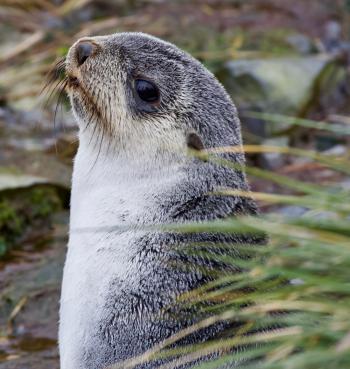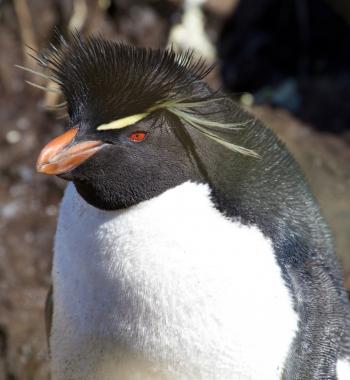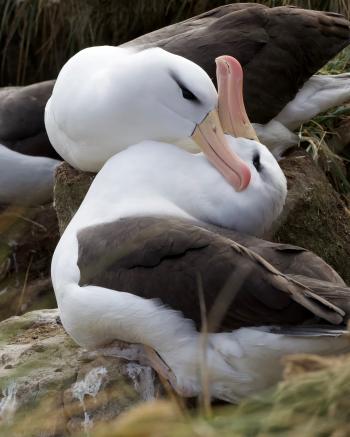Wonderful wilderness and wildlife on a cruise to South Georgia and the Falkland Islands
This article appears on page 6 of the July 2018 issue.
If you enjoy travel to pristine wilderness areas and observing wildlife up close, an expedition trip to the Arctic or Antarctic should be on your travel list.
When my wife, Betty, and I traveled to Antarctica in 2015, our trip didn’t include a visit to the Falklands (Islas Malvinas) or South Georgia. After travel discussions with others, we realized that we had missed out on exceptional bird, sea mammal and landscape viewing opportunities.
As we had enjoyed our two previous polar experiences, our next decision was whether to consider another, more inclusive Antarctica trip or focus only on an expedition visit to the Falklands and South Georgia.
Many polar expeditions spend only two to three days each in the Falklands and South Georgia, either on the way to or returning from Antarctica. Uncooperative weather and sea conditions can easily reduce the number of off-ship excursions when you have only a few days to visit each area. We decided that if we really wanted to increase our chances for as many viewing opportunities as possible, we needed to maximize the number ofdays in each destination.
With this in mind, we found that Poseidon Expeditions (Providence, RI; 347/801-2610, www.poseidon expeditions.com) offered the itinerary that matched our interests and price range ($25,000 for two, excludingflights).
In November 2017, we embarked on a 13-day expedition that started in Puerto Madryn, Argentina, and ended in Ushuaia. The expedition schedule included 2½ days in the Falkland Islands and 5½ days in South Georgia.
Beachside in Puerto Madryn
Flying from the US to South American destinations can often require balancing a number of flight schedules. For this trip, we started with Delta Air Lines flights from northern California to Santiago, Chile, via Atlanta ($9,000 for two round-trip business-class seats). From Santiago, we boarded a LATAM flight to Buenos Aires, Argentina ($700 for two economy seats).
Our flight schedules required us to book an overnight stay in downtown Buenos Aires. As there isn’t an airport hotel at the Ministro Pistarini International Airport (EZE), we stayed at the Alvear Art Hotel (Suipacha 1036; alvearart.com), located in the city center, for $350. The next day we flew on Aerolíneas Argentinas to Trelew ($700 for economy-plus tickets for two), continuing by van for the 35-minute ride to Puerto Madryn. Private vans and public buses routinely travel between Trelew and Puerto Madryn ($5-$14 per person).
Puerto Madryn is a beach resort town, with a long, sandy beach and a population of about 90,000. During our three days there, we stayed at the Dazzler Puerto Madryn (phone +54 280 4475758, www.dazzlerhoteles.com), a 9-story hotel with 95 rooms. Our 8th-floor room ($170 per night, including breakfast) had a terrific ocean view.
Our room did not, however, have an individual thermostat, and it was difficult to control the room’s warmth from the morning sun. By early afternoon, the sun would shift position and the room temperature would become much more pleasant.
Many visitors to Puerto Madryn go to enjoy the beach area, try snorkeling, enjoy fresh seafood and watch sea mammals. We enjoyed seeing the colorful houses that faced the shoreline, strolling down the pier to view the ships and viewing the cultural and scientific exhibits at Museo Provincial de Ciencias Naturales y Oceanografica (no admission fee).
We had planned to go over to the Musea del Desembarco, depicting the hardships of the first Welsh immigrants to this area, but it was closed during our stay.
One of the primary attractions of this area is the UNESCO World Heritage Site of Península Valdes, a nature reserve about an hour’s drive on paved and gravel roads from Puerto Madryn. This area is known for whale- and seal-watching and for its Magellanic penguin colonies.
Our visit was part of a pre-expedition excursion hosted by Poseidon Expeditions. During this visit, we went whale-watching aboard a small boat — seeing several southern right whales — and stopped for lunch at the San Lorenzo sheep ranch (www.pinguinospuntanorte.com.ar) in Punta Norte.
The ranch also manages a Magellanic penguin nature reserve that permits visitors to walk through a penguin rookery — a surprise in the sandy high-desert environment.
As in many resort towns, in Puerto Madryn there were many restaurants but time to try only a few. Two dinner favorites were Cantina El Nautico (Av. Julio Roca 790) and Chona (Av. Roca). While both restaurants had large numbers of menu items, the former had terrific seafood dishes and the latter had very good beef and lamb offerings.
We learned that dinner plates of meat can be large in Argentina and that sharing is acceptable in many restaurants.
The Lizard Café (Av. Gales 598) was a great lunch spot for pizzas, sandwiches, salads and local beer. During one of our walks, we stopped at the Havanna Café (Av. Roca 217) to relax over coffee, pastries and sandwiches.
The Falklands
Leaving Puerto Madryn aboard the MV Sea Spirit, a class 1D ice-strengthened ship, it took a little over two days to reach Carcass Island, in the northwest Falklands, the site of our first Zodiac excursion. This privatelyowned island operates as a sheep farm and is a great location for birding enthusiasts. We observed at least 25 different bird species, from large albatrosses, caracaras and upland geese to Antarctic terns and colorful oystercatchers. It was about the only stop in which we didn’t see elephant seals and fur seals lounging at the water’s edge.
Departing Carcass Island, we spent two at-sea days sailing to South Georgia. On our return from South Georgia to Ushuaia, we returned to the Falklands for two more days of excursions.
During this return route, we spent a day visiting Stanley, the capital of the Falklands, and nearby Gypsy Cove. We bypassed an anticipated landing at Saunders Island due to high winds and swells, making our final Falklands stop at West Point Island.
West Point Island was a highlight of our Falklands visit. There we had an opportunity to take a short hike and stop within just a few feet of nesting black-browed albatrosses and rockhopper penguins. It was terrific to just sit and observe these birds in such close proximity. (For those with mobility limitations, Land Rovers were available to drive guests to the observation area.)
Afterward, the West Point caretakers invited everyone for hot tea and a tabletop full of assorted home-baked cookies.
South Georgia
As we approached South Georgia, we understood that we would be extremely lucky to complete all the outings anticipated by the expedition leader. The ship moved up and down the South Georgia coastline, sometimes backtracking to take advantage of sheltered coves and areas with diminished winds and manageable sea swells. This movement permitted us to complete 12 excursions over six days — an extraordinary feat in notoriously windy South Georgia.
The South Georgia locations we visited included Godthul, where we hiked through hills lined with tussock grass to view a gentoo penguin colony and nesting albatrosses; Gold Harbour, offering views of manyelephant and fur seals; St. Andrews Bay, which hosts a colony of over 200,000 breeding pairs of king penguins, perhaps the largest colony in South Georgia, and Fortuna Bay, where passengers could re-create the historic hike to the Stromness Bay whaling station made by British explorer Ernest Shackleton, including a slide down an ice floe.
We also visited Drygalski Fjord, a 7-mile fjord that led to the Risting Glacier, and Grytviken, where we visited the graveyard where Shackleton and other early South Georgia pioneers are buried.
Salisbury Plain was our final South Georgia excursion. This coastal plain in the Bay of Isles is known for hosting about 30,000 breeding pairs of king penguins, and elephant and fur seals were abundant on the beach.
Sea conditions
The South Atlantic Ocean, between the Falklands and South Georgia, can be unpredictable. We thought this 2-day crossing would be milder than the Drake Passage crossing we had made on our earlier trip to Antarctica, but perhaps we were too optimistic.
On the initial outbound trip, we experienced relatively mild sea swells as we left Puerto Madryn and headed toward South Georgia via the Falklands. However, on our return crossing from South Georgia to the Falklands, we experienced two days of 9- to 18-foot sea swells and high winds.
Portholes were closed during that time, and many passengers took seasickness medication. Sleeping at night was a challenge as we rolled back and forth in our beds and, at times, felt like we were on a roller coaster.
Passengers were cautioned to be careful walking in the halls and stairways and to avoid walking on the exterior decks. Needless to say, it was difficult to stand while taking a shower, and several passengers missed a meal or two.
Life on board the Sea Spirit
The cabins on the Sea Spirit were well appointed and ranged from 200 to 300 square feet. We found our deck-five cabin, with sliding glass doors and a balcony, to be comfortable, but a lower-floor cabin would likelyhave been subject to a little less sea-swell movement. We heard that, during rough seas, passengers in bow-located cabins felt and heard noticeable bow movement as the ship plowed through the high swells.
Unlike a number of other small polar expedition ships, the Sea Spirit has an elevator. The elevator was helpful for those guests who could not easily navigate stairs between the ship’s decks.
No one went hungry on this cruise. Broad selections were available at breakfast and lunch buffets, and at dinner, starters, main dishes and desserts were chosen from a daily changing menu.
Mealtimes generally followed an established schedule, but the times could be adjusted if an excursion activity became possible. Excursions took priority over dining.
Teatime was observed at 4 p.m., with scones, finger sandwiches and pastries, and a never-empty cookie jar was enjoyed by all. Full bar service and 24-hour coffee and tea service also were offered.
The cabin stewards, dining staff and reception staff were always attentive.
With most polar expeditions, there are several at-sea days as you transit from one area to another. Poseidon Expeditions offered many talks during this time, covering topics such as birdlife, geology, sea mammals, area history and photography. Some guests used this time to head onto the decks to catch glimpses of whales, seals, dolphins and birds.
The only mandatory meetings were safety discussions and boot and jacket fittings and selection.
Zodiac excursions
The expedition leader and staff demonstrated their knowledge, experience and commitment to safe operations. Before we disembarked the ship for a Zodiac excursion, the expedition leader, staff and captain carefullyreviewed wind and wave conditions, weather forecasts and guest and staff safety guidelines.
We could also be alerted by the ship’s horn signal if an underway Zodiac activity had to be terminated early due to changing operational conditions.
Once operating conditions were affirmed and a loading time was announced, the inflatable rigid rubber boats were lowered from the ship. Passengers were assigned to groups of 30 to 40 individuals, and each groupwas given about a 10-minute alert to gather at the Sea Spirit’s Zodiac loading area.
Depending on sea conditions, each Zodiac was loaded with eight to ten passengers.
An excursion could be an actual shoreline landing or a scenic cruise. Just about all shoreline landings were “wet,” and our waterproof pants and muck boots kept us dry.
As we departed the Sea Spirit and after returning from a landing, we brushed and rinsed our rubber muck boots to avoid transmitting disease or invasive plant material from one area to another.
A surprise end
Disembarking the Sea Spirit in Ushuaia, we had a 2-night reservation ($243 per night) at the Arakur Resort & Spa (Cerro Alarkén 1; www.arakur.com). The Arakur is a modern hotel with wonderful coastal views, an on-site restaurant and convenient hiking access to the park next door, Cerro Alarkén Nature Reserve.
When we arrived at the Arakur, we were informed that a conference had reserved the hotel’s public areas and restaurant starting on the second day of our stay. Hotel staff had attempted to alert us earlier in our trip, but we had not purchased Internet access on the Sea Spirit due to slow and intermittent connections, so we did not get the message.
Arakur expressed concern that our stay would be inconvenienced by the conference and offered us one night at the Arakur and one night at the nearby Los Cauquenes Resort & Spa (De la Ermita 3462; www.loscauquenes.com) or two nights at the latter; we chose one night at each hotel.
Arakur covered the cost of both hotel stays and a dinner buffet for two with wine at its La Cravia restaurant.
Arakur’s guest service also helped us arrange remis, or taxi, service for a visit to the Train at the End of the World ($47 per person) and drop-off and pickup for a 5-mile hike along the coastal trail in Tierra del Fuego National Park ($21 per person for one-day park entry). I can’t recall experiencing such wonderful customer service in our many years of travel.
Overall, we thoroughly enjoyed our third polar trip. The spectacular scenery and the opportunity to observe wildlife and birds were special to us.
Poseidon Expeditions’ staff provided a terrific experience for everyone.
For those thinking about a polar visit, an expedition cruise that includes shore landings should be strongly considered if you are physically able to handle Zodiac travel.

-itok=c5BL4YAv.jpg)

-itok=4f64tuyt.jpg)
-itok=K_dzzE8e.jpg)

